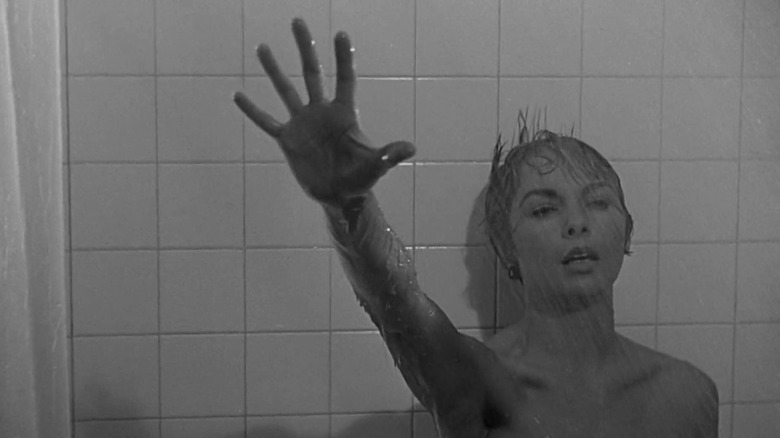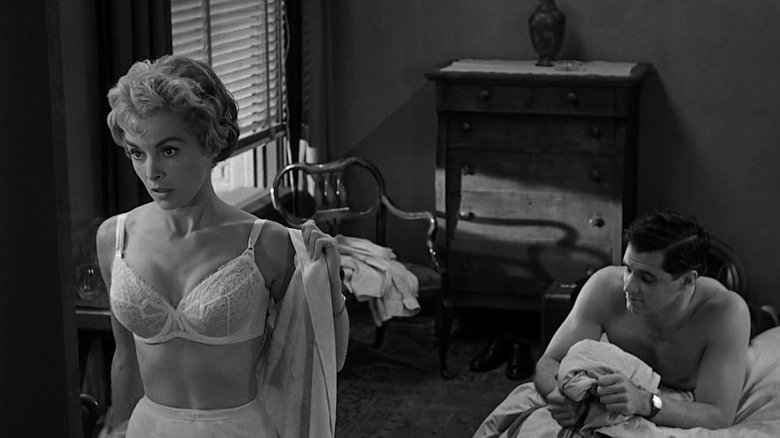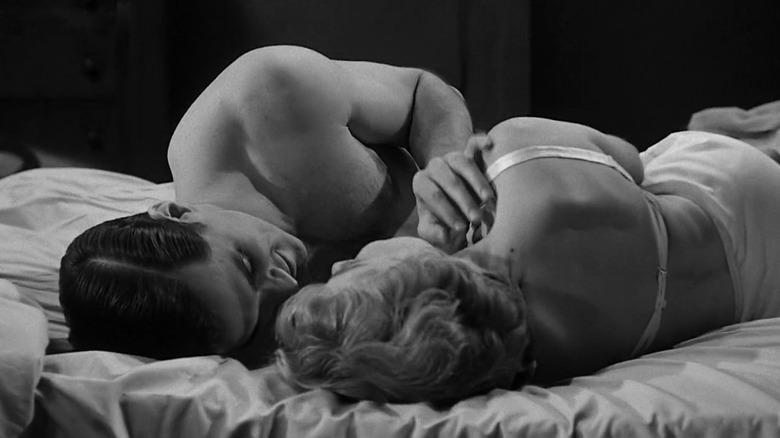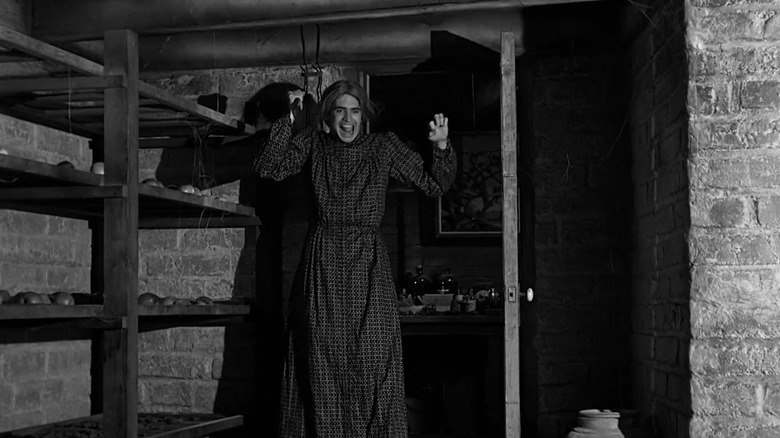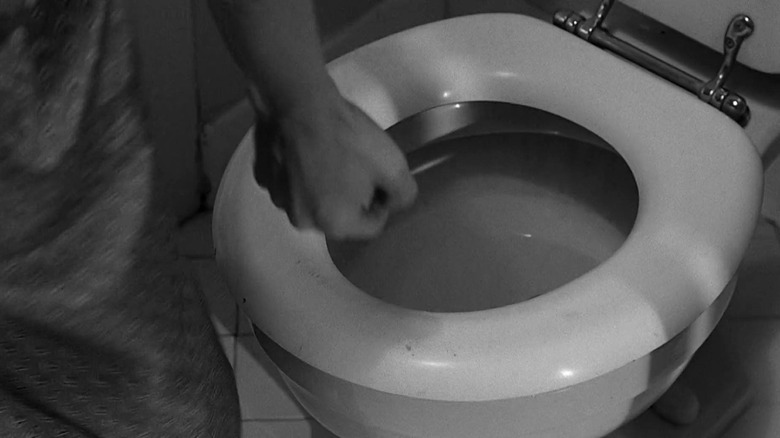Surprisingly, Psycho Was The First Film To Ever Show This
"It is required that you see 'Psycho' from the very beginning!"
When audiences first took their seats, it was clear that "Psycho" was going to be something worth talking about. Taking a cue from the William Castle playbook of gimmicks, director Alfred Hitchcock introduced a "no late admission" policy, with a poster showing the director pointing sternly at his watch (via CFI). To ramp up anticipation of the terrifying material within the film, he also hired "nurses" to stand around in cinema lobbies for early screenings, in case anyone suffered a heart attack (via Today I Found Out). How could you not see a movie with those gimmicks in place?
After the glossy spy thriller "North By Northwest," Hitchcock was looking for a change in direction. He landed on Robert Bloch's novel, "Psycho," and thought it had so much potential that he purchased the rights and tasked his assistant with buying up every copy she could find to preserve the story's twists and turns.
Paramount didn't want to make the film at all, resulting in Hitchcock funding the film himself, waiving his usual fee and taking a stake in the final product instead. Shooting in black and white with his "Alfred Hitchcock Presents" TV crew to keep costs down, Hitchcock's gamble paid off. "Psycho" was a hit and became one of the most influential horror movies in cinema history, stunning audiences by killing off the film's biggest star halfway through in the now famous shower scene.
"Psycho" was strong stuff for its time, shocking in its depiction of violence and provocative in how it portrayed sexual relationships and other controversial issues. It even featured one moment so contentious that it had never been shown in a Hollywood movie before. So, what was this cinematic milestone? Let's break it down, starting with the transgressive elements that seem like they'd fit the bill, but don't.
A Woman Wearing a Bra? Nope!
During the opening scene in the hotel room, Leigh is dressed in just a white bra and slip, indulging in a spot of post-coital canoodling on the bed with her boyfriend. This was all pretty racy for the time, and Hitchcock and his publicity team leaned into the potential controversy in the film's poster campaign. Although the restrictive Motion Picture Production Code (aka the Hays Code) was in decline by the time "Psycho" was released, filmmakers still risked the wrath of the censors by showing women in various states of undress or suggestions of sex (via Syfy). It was even more daring to show Janet Leigh, one of the biggest stars in Hollywood at the time, in just underwear and baring her midriff on the poster, along with the lurid tagline "A new — and altogether different — screen excitement!!!"
Despite this, it was far from a Hollywood first, although the idea of what a bra actually was changed significantly in the post-war years. The underwire style bra worn by Leigh in the scene, while developed in the '30s, only became a common garment in the '50s when metal was freed up for domestic use after World War II. Famously, Howard Hughes used his engineering skills to design an underwired push-up bra to amplify Jane Russell's breasts in 1943's "The Outlaw." However, pre-Hays Code, there were plenty of examples of women on screen wearing the period equivalent, from bralettes to lingerie (via The Lingerie Addict). One very early example of an actress wearing a bra-like top was Mae Murray's elaborate costume in "Peacock Alley" from 1922.
An Unmarried Man and Woman Sharing a Bed? Nah!
The opening scene of "Psycho" also broke another taboo, showing the unmarried Marion and Sam kissing and cuddling half-naked on a hotel bed. A man and woman sharing a bed was a big deal for a long time in Hollywood, even before the Hays Code. The precursor of the legislation, 1927's "The Don'ts and Be Careful's" guidelines of the Motion Picture Producers and Distributors of America, listed "Man and woman in bed together" as something to tread carefully with, on the grounds that "vulgarity and suggestiveness may be eliminated and that good taste may be emphasized." The standard solution was to have bedroom scenes, even for married characters in movies, with two single beds, usually separated by a nightstand.
Director Otto Preminger, who challenged the Hays Code by using forbidden words in "The Moon is Blue" and depicting drug addiction in "The Man With the Golden Arm" in the '50s (via Los Angeles Times), was delighted to break the bed-sharing rule in his 1944 film "In the Meantime, Darling." It was the first motion picture to show a married couple sharing a bed since the Code was established ten years earlier.
Although the Hays Code was in decline by the time Hitchcock made "Psycho," opening a movie with an unmarried couple in bed together was risky, and censors wanted the scene changed. Crafty Hitchcock tricked them with an invite to a reshoot, but the censors never showed up and the scene remained unaltered (via History.com).
Cross Dressing? Not at all!
Another contentious issue in "Psycho" was Norman Bates dressing up in a wig and his mother's clothes towards the gruesome reveal in the film's third act, although the film itself debates whether he is truly a transvestite because, when he switches to mommy mode, he actually believes he is his mother. Cross-dressing in movies was far from a new thing; Billy Wilder's "Some Like it Hot," with Tony Curtis and Jack Lemmon spending much of the film dressed as women, was a big hit the previous year.
Meanwhile out in the real world, some members of the LGBTQ community faced harassment and arrest for cross-dressing in public (via History.com), something that schlock filmmaker Ed Wood passionately argued against in his semi-autobiographical "Glen or Glenda?" earlier in the '50s.
It has been argued (via The Scattered Pelican) that Norman's cross-dressing was another type of screen first: "Psycho [provided] the original model of the mentally disturbed cross-dressed murderer."
It was a trope that would appear many movies over the coming decades, like "Sleepaway Camp," "Dressed to Kill," and "The Silence of the Lambs," and is now provoking discussion in a modern context. As Harmony Colangelo writes in her excellent article on the subject (via Bloody Disgusting):
While I do not think it was the intent of all of these creators to specifically target trans women, the impact of the films they created exploited public unease towards people like myself and that attitude continues today. To the uninformed, the fear of there being a killer is usurped by the killer being a woman who is "lying" about being a woman. That queer panic becomes the new central fear and this equates trans people to a grab bag of destructive assumptions. The trans panic becomes more scary than the threat of death.
A Flushing Toilet? Yes!
Yes, believe it or not, "Psycho" is widely regarded to be the first Hollywood movie to show an onscreen toilet flush. Scenes featuring the humble lavatory were often discouraged by the Production Code Administration, something that Hitchcock fell foul of earlier in his career. In his 1941 film "Mrs & Mrs Smith," Hitchcock planned a scene where a conversation in a bathroom was repeatedly interrupted by the sound of a flushing toilet on the floor above. Worried about the censors, RKO persuaded him to use clanking pipes instead (via The Hitchcock Zone).
Toilets were visible in previous Hollywood films, such as King Vidor's 1928 film "The Crowd," and the sound and image of a loo flushing finally came together in "Psycho." Just before Marion disrobes to take her final shower, she rips up an incriminating note, tosses it in the bowl, and yanks the handle. We see the water rising, but the great director doesn't linger long enough for us to see the scraps disappear around the bend. She's a bit careless about it, though, as one piece misses the bowl for private eye Arbogast (Martin Balsam) to discover later. This evidence was switched from a lost ring in Bloch's novel to the ripped-up note because Hitchcock thought the toilet moment would give the film some added realism.
By modern standards, the shot is totally innocuous, but where would we be without it? Would we have Jeffrey Lebowski getting his head repeatedly dunked in the toilet? Vincent Vega's fatal bathroom break? Or Jeff Daniel's unfortunate case of the squits in "Dumb and Dumber?" Cinema owes Hitchcock a great debt of gratitude for breaking that taboo.
